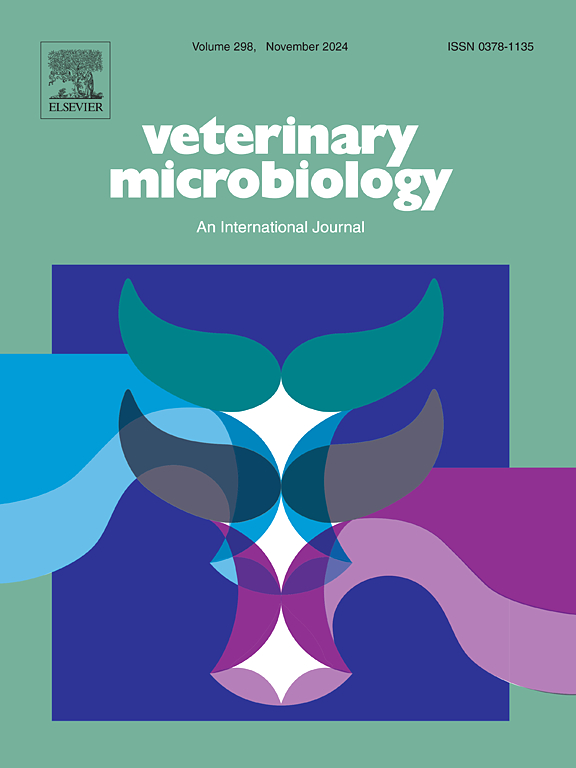与新生猪败血症爆发有关的肺炎克雷伯氏菌的毒力决定因素
IF 2.4
2区 农林科学
Q3 MICROBIOLOGY
引用次数: 0
摘要
本文章由计算机程序翻译,如有差异,请以英文原文为准。
Virulence determinants in Klebsiella pneumoniae associated with septicaemia outbreaks in neonatal pigs
Klebsiella pneumoniae is recognized as an opportunistic pathogen in pigs causing pneumonia, mastitis and diarrhoea, but can also cause mortalities due to septicaemia and meningitis in previously healthy piglets. This study aimed to identify virulence genes present in K. pneumoniae that caused outbreaks of septicaemia in neonatal pigs. The genomes of thirty-eight Australian K. pneumoniae isolates from pigs with septicaemia, meningitis, myocarditis, pneumonia, enteritis and healthy cohorts were sequenced. The presence of antimicrobial resistance, siderophore and enhanced capsule production genes were identified by sequence analysis and verified by either PCR or phenotypic tests. An additional 52 international K. pneumoniae genomes from healthy and clinically affected pigs (28), humans (16), birds (3), one rodent and environmental isolates (4) were included in a pangenome analysis. Porcine septicaemic K. pneumoniae genomes from the UK and Australia clustered together and had higher virulence scores than all other clinical and non-clinical isolates. Septicaemic isolates were predominantly ST25, had enhanced capsule polysaccharide production with K2 capsule type and contained genes for the siderophores aerobactin, salmochelin and yersiniabactin. Septicaemic K. pneumoniae were more likely to have genes encoding the assembly of LPS, fimbriae and adhesins, and enzymes needed for the integration of mobile genetic elements. No single virulence gene was solely associated with isolates causing septicaemia. These findings indicate that there may be genotypes associated with clinical disease outcomes for K. pneumoniae. In the absence of some virulence genes, K. pneumoniae was still able to cause significant disease if the pig’s immune system was immature or compromised.
求助全文
通过发布文献求助,成功后即可免费获取论文全文。
去求助
来源期刊

Veterinary microbiology
农林科学-兽医学
CiteScore
5.90
自引率
6.10%
发文量
221
审稿时长
52 days
期刊介绍:
Veterinary Microbiology is concerned with microbial (bacterial, fungal, viral) diseases of domesticated vertebrate animals (livestock, companion animals, fur-bearing animals, game, poultry, fish) that supply food, other useful products or companionship. In addition, Microbial diseases of wild animals living in captivity, or as members of the feral fauna will also be considered if the infections are of interest because of their interrelation with humans (zoonoses) and/or domestic animals. Studies of antimicrobial resistance are also included, provided that the results represent a substantial advance in knowledge. Authors are strongly encouraged to read - prior to submission - the Editorials (''Scope or cope'' and ''Scope or cope II'') published previously in the journal. The Editors reserve the right to suggest submission to another journal for those papers which they feel would be more appropriate for consideration by that journal.
Original research papers of high quality and novelty on aspects of control, host response, molecular biology, pathogenesis, prevention, and treatment of microbial diseases of animals are published. Papers dealing primarily with immunology, epidemiology, molecular biology and antiviral or microbial agents will only be considered if they demonstrate a clear impact on a disease. Papers focusing solely on diagnostic techniques (such as another PCR protocol or ELISA) will not be published - focus should be on a microorganism and not on a particular technique. Papers only reporting microbial sequences, transcriptomics data, or proteomics data will not be considered unless the results represent a substantial advance in knowledge.
Drug trial papers will be considered if they have general application or significance. Papers on the identification of microorganisms will also be considered, but detailed taxonomic studies do not fall within the scope of the journal. Case reports will not be published, unless they have general application or contain novel aspects. Papers of geographically limited interest, which repeat what had been established elsewhere will not be considered. The readership of the journal is global.
 求助内容:
求助内容: 应助结果提醒方式:
应助结果提醒方式:


